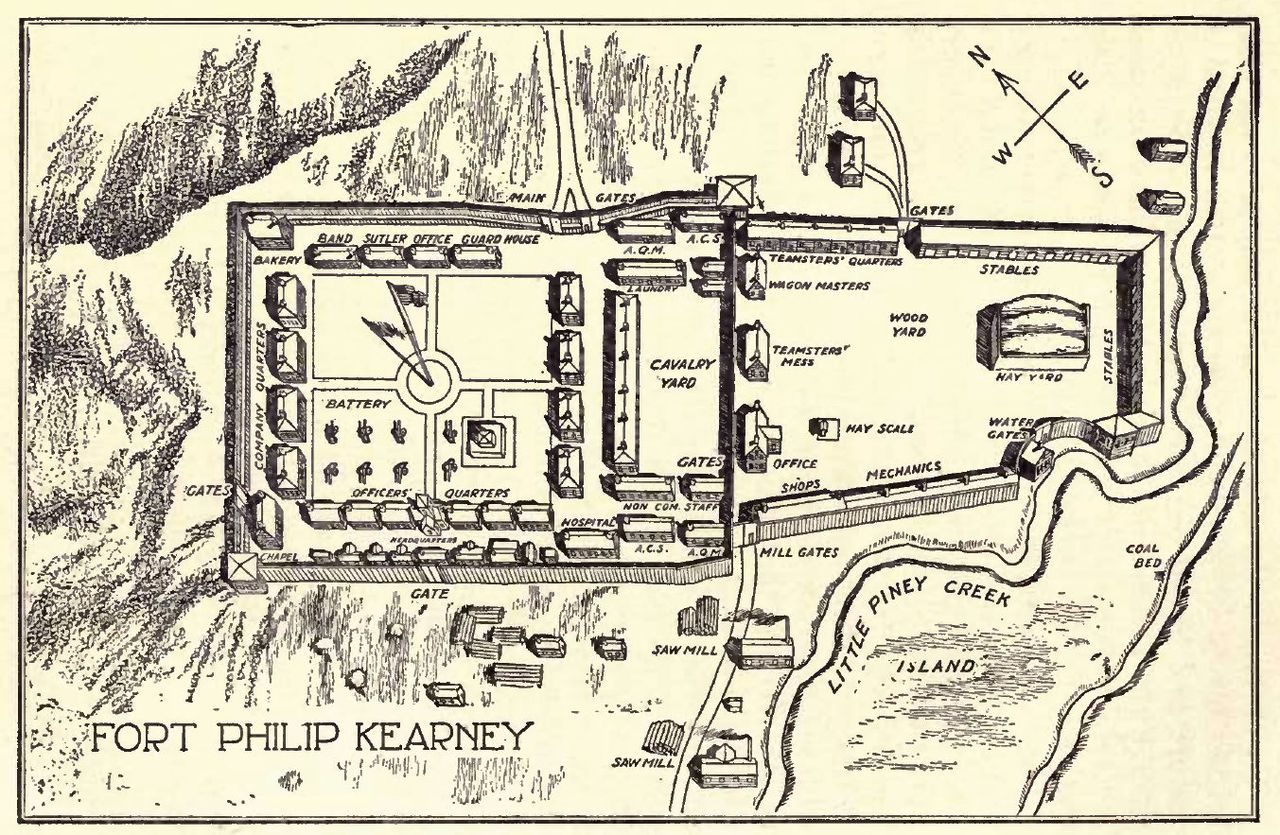Fort Phil Kearny, established in 1866 in present-day Johnson County, Wyoming, played a crucial role during westward expansion by protecting travelers on the Bozeman Trail.
Named after Union General Philip Kearny, the fort became a focal point during Red Cloud’s War, enduring several attacks from Native American tribes.
The Fetterman Fight, a significant battle in 1866, saw Native warriors defeat a US force.
Today, the site is a preserved historical landmark that educates visitors about the conflicts between the US military and Native tribes during this turbulent period.
History of Fort Phil Kearny (Wyoming)
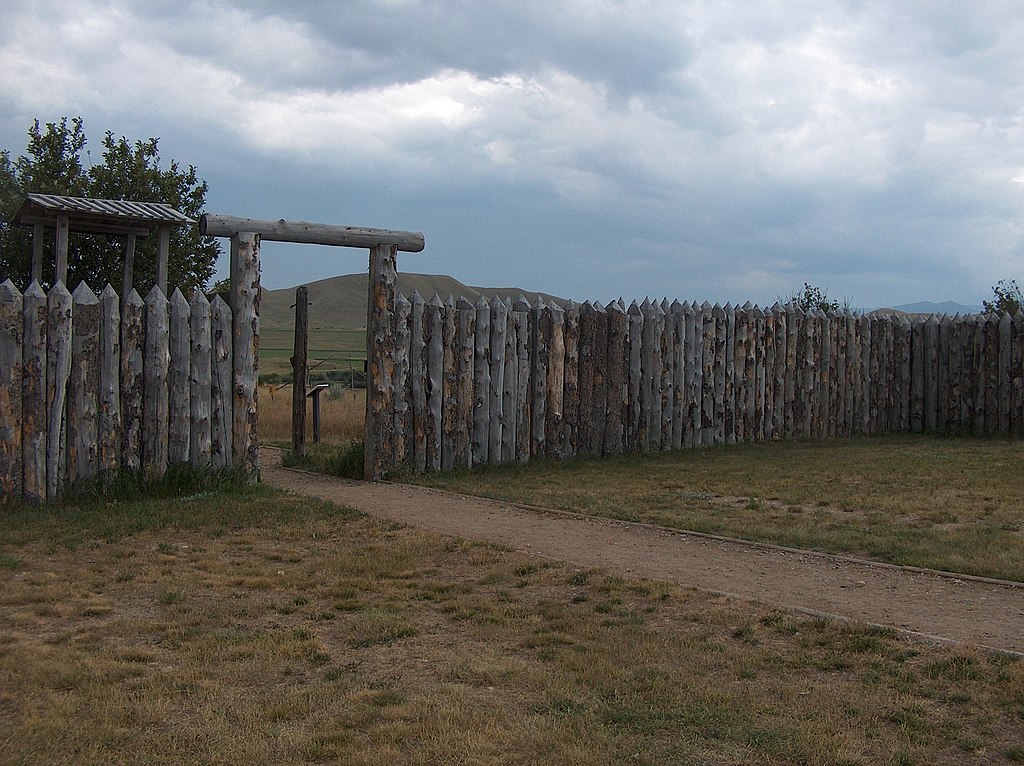
Established in 1866, Fort Phil Kearny was a US Army outpost in present-day Johnson County, Wyoming.
Its primary role was to protect travelers on the Bozeman Trail during the height of westward expansion. The fort was named after Philip Kearny, a respected Union General from the American Civil War.
Key Events:
- Foundation: Constructed as part of the military’s response to increasing conflicts with Native American tribes.
- Red Cloud’s War: The fort was central during the Red Cloud’s War, facing several attacks by a coalition of Lakota, Cheyenne, and Arapaho tribes.
- The Fetterman Fight: The fort is perhaps best known for the Fetterman Fight, which occurred on December 21, 1866, when a force led by Captain William J. Fetterman was defeated by Native American warriors.
Design and Structure:
- Layout: The fort featured a prairie-style rectangular design with wooden defenses.
- Garrison: It could house around 400 soldiers but was often understaffed due to its remote location.
Decommissioning:
- The Treaty of Fort Laramie (1868) led to the closure and abandonment of Fort Phil Kearny as the US government agreed to withdraw forces and close the Bozeman Trail.
Legacy:
Today, Fort Phil Kearny is a historic site where visitors can learn about this turbulent period in Western history.
It has been preserved to educate on the conflicts between the US military and Native American tribes during westward expansion.
Fort Phil Kearny is a crucial historical point of reference for studies related to the Indian Wars and the development of the American West.
Timeline:
- 1866: Establishment
- December 21, 1866: Fetterman Fight
- 1868: Treaty of Fort Laramie and decommissioning
Fort Construction
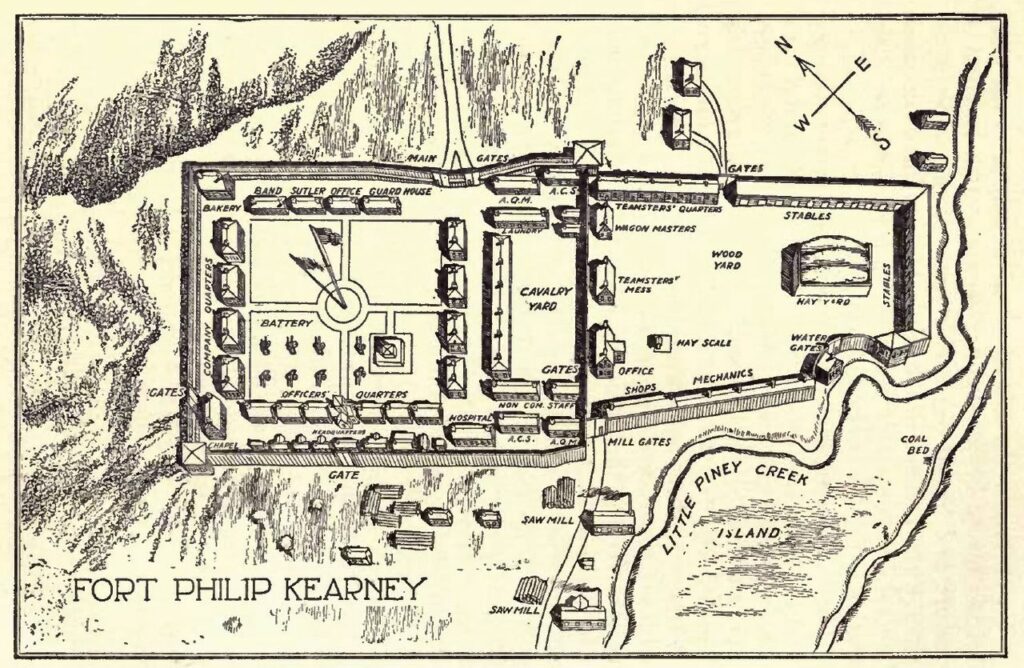
Fort Phil Kearny was constructed in 1866 as a U.S. Army outpost on the Bozeman Trail at the height of conflicts with indigenous tribes during the westward expansion.
The fort’s construction was crucial for protecting travelers and asserting the U.S. presence in a strategically contested region.
Location and Strategic Importance
The fort was strategically located near present-day Story, Wyoming, amid the rolling hills of the Powder River Country.
Its placement was selected for its:
- Proximity to the Bozeman Trail
- Access to nearby water sources like Piney Creek
- Visibility of surrounding terrain for defense
The location was critical as it served as a midway point protecting the influx of miners and settlers traveling to the Montana Territory.
Design and Architecture
Fort Phil Kearny’s design was practical and functional. Key features included:
- Rectangular shape, with dimensions of approx. 600 feet by 800 feet
- Enclosed by an 8-foot tall log palisade for defense
- Buildings arranged in a parallelogram pattern within the fort’s perimeter
The interior housed barracks, stables, a guardhouse, officers’ quarters, and a hospital, all pivotal for sustaining military operations and ensuring the well-being of occupants.
Construction Challenges
The construction of Fort Phil Kearny faced numerous difficulties:
- Hostile Incursions: Frequent attacks by Lakota, Cheyenne, and Arapaho warriors impeded progress.
- Resource Scarcity: Building materials like lumber were scarce, requiring transportation from distant locations.
- Harsh Climate: Extreme weather conditions, including harsh winters, hampered construction activities.
Despite these challenges, the fort was erected relatively quickly, underscoring the U.S. military’s resolve and determination and the significance they placed on establishing a foothold in the region.
The Fort’s Role
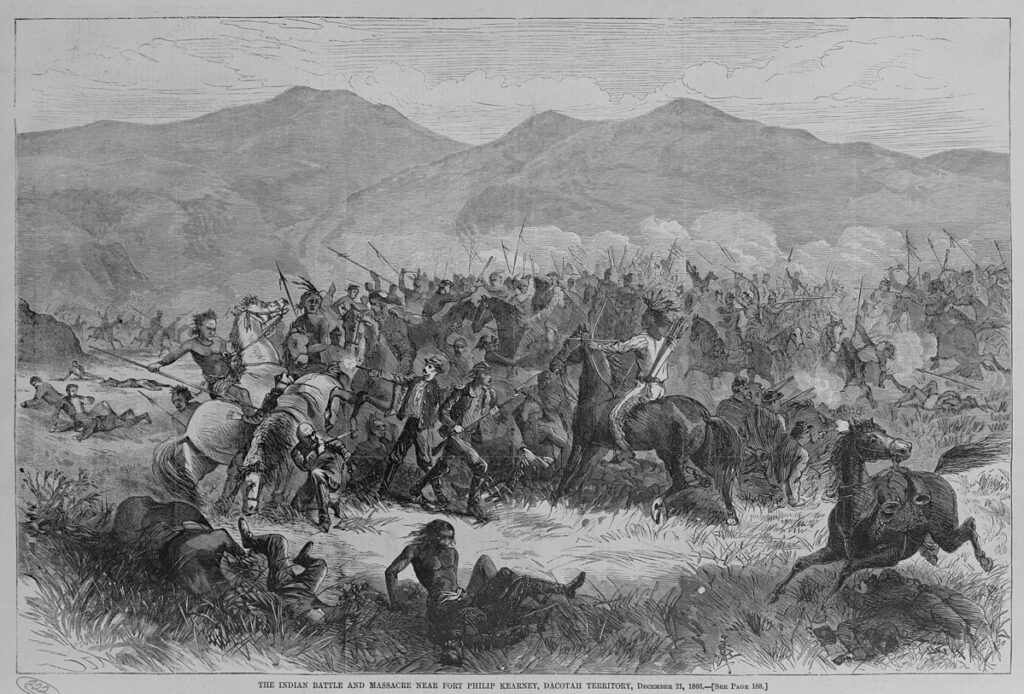
Fort Phil Kearny played a strategic part in the United States military operations and actively participated in Red Cloud’s War.
Military Significance
Established in 1866, Fort Phil Kearny was one of the most important military outposts during the Indian Wars.
Its location near the Bozeman Trail was strategic for controlling the routes used by immigrants moving westward.
The fort’s construction aimed to protect travelers from attacks by the Lakota Sioux, Northern Cheyenne, and Arapaho tribes.
The presence of the fort’s garrison deterred aggressions and secured a military foothold in the contested territories.
Role in Red Cloud’s War
During Red Cloud’s War, Fort Phil Kearny was a significant site of conflict between the United States military and the aforementioned tribes.
Red Cloud, a respected leader of the Oglala Lakota, led a successful campaign against the military forts designed to safeguard the trail.
The fort withstood frequent attacks, the peak of which was the Fetterman Fight in 1866, where a sizeable military detachment was overpowered by a coalition of Native warriors.
Hostilities persisted until the war ended, resulting in the 1868 Treaty of Fort Laramie and the fort’s abandonment.
Fort Phil Kearny’s role during this period highlighted the time’s intense military and cultural clashes.
Life at the Fort Phil Kearny
Fort Phil Kearny was a significant outpost during the turbulent mid-1860s. Its inhabitants lived a life dictated by necessity and survival, interacting with native tribes and facing supply challenges.
Daily Activities of Soldiers
The typical day for soldiers at Fort Phil Kearny involved a rigid routine.
Mornings commenced with reveille, a wake-up call followed by a roll call.
Daily duties included drills, fort maintenance, and patrols in the surrounding areas to ensure safety and show presence.
Evenings were spent in preparation for the next day, with time allocated for personal care and rest.
Relationship With Native Tribes
Interactions with Native American tribes were complex and often tense.
Soldiers were tasked with protecting settlers and maintaining the fort as a supply station for emigrants.
Conflict arose as the fort encroached on the hunting grounds of the Lakota, Northern Cheyenne, and Arapaho tribes, leading to frequent skirmishes and the need for strategic negotiation.
Supplies and Logistics
The fort depended on a steady flow of supplies, which was challenging due to its remote location.
A supply chain from Fort Laramie was maintained, which required constant military escort. Critical items included:
- Food: primarily non-perishable goods like hardtack, beans, and salted meat.
- Ammunition and weapons: essential for defense and hunting.
- Building materials: necessary for repairs and expansions.
Logistical efficiency was crucial for the fort’s sustainability, demanding keen attention to detail and thorough record-keeping.
Conflicts and Battles
Fort Phil Kearny, located in present-day Wyoming, was the scene of significant military engagements between United States troops and Indigenous peoples, notably the Sioux, Cheyenne, and Arapaho tribes.
Fetterman Fight
On December 21, 1866, the Fetterman Fight marked one of the most significant clashes near Fort Phil Kearny.
Captain William J. Fetterman led a detachment of 80 soldiers in response to a decoy party from the Lakota, Cheyenne, and Arapaho in this conflict. The unit was led into an ambush, resulting in all the soldiers’ deaths.
Wagon Box Fight
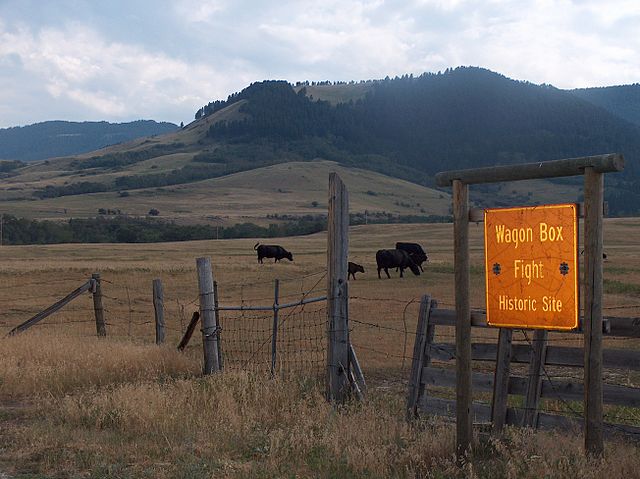
Less than a year after the Fetterman Fight, the Wagon Box Fight occurred on August 2, 1867.
A smaller force of 32 soldiers, utilizing wagon boxes for defensive positions, withstood an attack by 1,000 warriors. The soldiers’ use of new breech-loading rifles contributed to their successful defense and survival.
Other Skirmishes
Fort Phil Kearny also witnessed numerous smaller skirmishes between soldiers and Indigenous tribes.
These incidents mainly involved attacks on woodcutting parties and supply trains, as the tribes sought to hinder the fort’s operation and the westward expansion of settlers.
These continuous tensions underscored the broader conflicts of the Indian Wars during that period.
Explore More: 15 Historic Forts in Wyoming
Abandonment and Aftermath
Fort Phil Kearney in Wyoming was officially abandoned in 1868. The reasons were multifaceted: the site’s military utility had waned, and escalating costs made its upkeep untenable.
Following its abandonment, the fort fell into private hands, and its materials were repurposed.
Efforts have been made to preserve the site and acknowledge its historical significance.
Causes of Abandonment
Military strategies changed after the Fort Laramie Treaty of 1868, making the fort redundant.
Fiscal concerns also played a role; high operation costs and continued conflict with Native American tribes were unsustainable.
The dwindling necessity for such forts, in general, contributed to its closure.
Post-Military Use
Upon abandonment, local civilians dismantled the fort for its resources.
Materials salvaged from the site were used to construct new buildings in the surrounding areas.
No longer of strategic importance, the land transitioned into civilian ownership and was repurposed for agriculture and other private uses.
Preservation Efforts
- Designation: Fort Phil Kearney was designated a National Historic Landmark in 1960.
- Site Management: The Fort Phil Kearney State Historic Site manages the site.
- Visitor Access: Public access is facilitated with on-site interpretive tours and educational programs.
Historical markers and reconstructed buildings now illustrate the fort’s past, ensuring its legacy remains part of American history.
Preservation groups work to maintain the integrity of the site’s remaining structures and the grounds where significant conflicts of the Indian Wars occurred.
Cultural Impact
The cultural impact of Fort Phil Kearney is evident through its representation in literature and media, its preservation as a historical site, and its role in education.
In Literature and Media
Fort Phil Kearney has been depicted in various literary works and media productions, emphasizing its role in American history.
Notable mentions include Dee Brown’s novel Fetterman’s Massacre and the film The Red Man’s View, which reflect on military conflict and interactions with Native American tribes.
Fort Phil Kearney Today
Today, the site of Fort Phil Kearney stands as a monument to this period in American history.
It includes a visitor center, which provides tourists and history enthusiasts with insights into the fort’s life and times.
Preservation efforts ensure the longevity of this historical landmark for future generations to appreciate.
Educational Outreach
The fort’s educational programs offer an array of activities geared toward learning about the site’s history and the Indian Wars.
- Guided tours
- School group programs
These initiatives aim to engage students and the public in understanding this aspect of Western American history.

Cory is a website owner and content creator who enjoys fishing, history, coin collecting, and sports, among other hobbies. He is a husband and father of four.
Romans 15:4 For whatever was written in former days was written for our instruction, that through endurance and through the encouragement of the Scriptures we might have hope.

